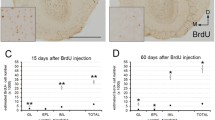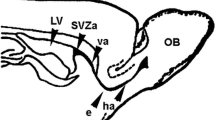Summary
In the rat olfactory bulb, the majority of interneurons in the glomerular layer (GL) are supposed to be generated during first postnatal week. Low and repeated doses of X-rays (200 rad x 4 and 200 rad x 6) were used during this period to impair the development of interneurons. The resulting effects on olfactory bulb neurons were examined stereologically and immunocytochemically in animals of 4 and 12 weeks of age. Quantitative analysis showed that, 1) the volume of the GL decreased to 55% (1200 rad) – 70% (800 rad) of control, 2) numerical cell densities in GL decreased to 40% (1200 rad) – 60% (800 rad) of control, thus resulting in 3) a decrease of the total cell number in GL to 20% (1200 rad) – 40% (800 rad) of control in irradiated olfactory bulbs of animals 4 weeks old. In comparison, mitral cells, which are generated prenatally, were much less affected (total cell number: 70–80% of control), indicating a selective loss of cells generated during the first postnatal week in GL. Effects on somata and processes immunoreactive for GABA, tyrosine hydroxylase (TH), calbindin D-28K and parvalbumin (PV) were examined in irradiated bulbs of both 4 and 12 week-old rats. All of these immunoreactive elements showed a drastic decrease in all layers. Semiquantitative analysis showed that in the GL, calbindin D-28K immunoreactive (calbindin D-28K(+)) neurons decreased more extensively than TH immunoreactive (TH(+)) and GABA-like immunoreactive (GABA(+)) neurons; that is, TH(+) and GABA(+) neurons decreased to 20% (1200 rad) – 40% (800 rad) of control, whereas calbindin D-28K(+) neurons decreased to 10% (1200 rad) – 30% (800 rad) of control in the GL of irradiated bulbs. These findings indicated that larger proportions of calbindin D-28K(+) neurons might be generated during the first postnatal week than those of GABA(+) and TH(+) neurons. Furthermore, in irradiated bulbs the proportion of GABA(-)TH(+) cells in TH(+) cells increased to about twice of control, and the estimated total numbers of GABA(-)TH(+) cells in irradiated rats were 95% (800 rad) and 40% (1200 rad) of control. These observations suggest that the majority of GABA(-)TH(+) neurons were less affected by X-ray irradiation during the first postnatal week and thus that they might be generated in the prenatal period. Since during the first 2 postnatal weeks, neurons showing GABA(-)TH(+) were not seen in GL (Kosaka et al. 1987a), the majority of GABA(-)TH(+) neurons in adult olfactory bulb were assumed to change their phenotype at some postnatal developmental period.
Similar content being viewed by others

References
Altman J, Anderson WJ, Wright KA (1968) Differential radiosensitivity of stationary and migratory primitive cells in the brains of infant rats. Exp Neurol 22:52–74
Baimbridge KG, Miller JJ (1982) Immunohistochemical localization of calcium-binding protein in the cerebellum, hippocampal formation and olfactory bulb of the rat. Brain Res 245:223–229
Bayer SA (1983) 3H-thymidine-radiographic studies of neurogenesis in the rat olfactory bulb. Exp Brain Res 50:329–340
Bayer SA, Altman J (1975a) The effects of X-irradiation on the postnatally-forming granule cell populations in the olfactory bulb, hippocampus, and cerebellum of the rat. Exp Neurol 48:167–174
Bayer SA, Altman J (1975b) Radiation-induced interference with postnatal hippocampal cytogenesis in rats and its long-term effects on the acquisition of neurons and glia. J Comp Neurol 163:1–20
Bogan N, Brecha N, Gall C, Karten HJ (1982) Distribution of enkephalin-like immunoreactivity in the rat main olfactory bulb. Neuroscience 7:895–906
Celio MR (1990) Calbindin D-28k and parvalbumin in the rat nervous system. Neuroscience 35:375–475
Davis BJ, Macrides F (1983) Tyrosine hydroxylase immunoreactive neurons and fibers in the olfactory system of the hamster. J Comp Neurol 214:427–440
Gundersen HJG (1986) Stereology of arbitrary particles. A review of unbiased number and size estimators and the presentation of some new ones, in memory of William R. Thompson. J Microsc 143:3–45
Gundersen HJG, Jensen EB (1987) The efficiency of systematic sampling in stereology and its prediction. J Microsc 147:229–263
Halász N (1986a) Early X-irradiation of rats. 1. Methodological description and morphological observations on the olfactory bulb. J Neurosci Meth 18:255–268
Halász N (1986b) Early X-irradiation of rats. 2. Effect on granule cells and their dendrodendritic synapses in the olfactory bulb. Neuroscience 20:709–716
Halász N (1987) Early X-irradiation of rats. 3. Survival of dopaminergic periglomerular cells of the olfactory bulb. Z Microsk Anat Forsch 101:1027–1034
Halász N, Hökfelt T, Norman AW, Goldstein M (1985) Tyrosine hydroxylase and 28K-Vitamin D-dependent calcium binding protein are localized in different subpopulations of periglomerular cells of the rat olfactory bulb. Neurosci Lett 61:103–107
Halász N, Johansson O, Hökfelt T, Ljungdahl Å, Goldstein M (1981) Immunohistochemical identification of two types of dopamine neuron in the rat olfactory bulb as seen by serial sectioning. J Neurocytol 10:251–259
Halász N, Ljungdahl Å, Hökfelt T, Johansson O, Goldstein M, Park D, Biberfeld P (1977) Transmitter histochemistry of the rat olfactory bulb. 1. Immunohistochemical localization of monoamine synthesizing enzymes. Support for intrabulbar, periglomerular dopamine neurons. Brain Res 126:455–474
Halász N, Ljungdahl Å, Hökfelt T (1978) Transmitter histochemistry of the rat olfactory bulb. 2. Fluorescence histochemical, autoradiographic and electron microscopic localization of monoamines. Brain Res 154:253–271
Halász N, Shepherd GM (1983) Neurochemistry of the vertebrate olfactory bulb. Neuroscience 10:579–619
Hicks SP (1958) Radiation as an experimental tool in mammalian developmental neurology. Physiol Rev 38:337–356
Hsu S-M, Raine L, Fanger H (1981) Use of avidin-biotinperoxidase complex (ABC) in immunoperoxidase techniques. J Histochem Cytochem 29:577–580
Kägi U, Berchtold MW, Heizmann CW (1987) Ca2+-binding parvalbumin in the rat testis: characterization, localization, and expression during development. J Biol Chem 262:7314–7320
Kosaka T, Hataguchi Y, Kama K, Nagatsu I, Wu J-Y (1985a) Coexistence of immunoreactivities for glutamate decarboxylase and tyrosine hydroxylase in some neurons in the periglomerular region of the rat main olfactory bulb: possible coexistence of gamma-aminobutyric acid (GABA) and dopamine. Brain Res 343:166–171
Kosaka T, Kosaka K, Tateishi K, Hamaoka Y, Yanaihara N, Wu J-Y, Hama K (1985b) GABAergic neurons containing CCK-8-like and/or VIP-like immunoreactivities in the rat hippocampus and dentate gyrus. J Comp Neurol 239:420–430
Kosaka T, Nagatsu I, Wu J-Y, Hama K (1986) Use of high concentrations of glutaraldehyde for immunocytochemistry of transmitter-synthesizing enzymes in the central nervous system. Neuroscience 18:975–990
Kosaka K, Hama K, Nagatsu I, Wu J-Y, Ottersen OP, Storm-Mathisen J, Kosaka T (1987a) Postnatal development of neurons containing both catecholaminergic and GABAergic traits in the rat main olfactory bulb. Brain Res 403:355–360
Kosaka T, Kosaka K, Hataguchi Y, Nagatsu I, Wu J-Y, Ottersen OP, Storm-Mathisen J, Hama K (1987b) Catecholaminergic neurons containing GABA-like and/or glutamic acid decarboxylase-like immunoreactivities in various brain regions of the rat. Exp Brain Res 66:191–210
Kosaka T, Kosaka K, Heizmann CW, Nagatsu I, Heizmann CW, Nagatsu I, Wu J-Y, Yanaihara N, Hama K (1987c) An aspect of the organization of the GABAergic system in the rat main olfactory bulb: laminar distribution of immunohistochemically defined subpopulations of GABAergic neurons. Brain Res 411:373–378
Kosaka K, Hama K, Nagatsu I, Wu J-Y, Kosaka T (1988) Possible coexistence of amino acid (γ-aminobutyric acid), amine (dopamine) and peptide (substance P); neurons containing immunoreactivities for glutamic acid decarboxylase, tyrosine hydroxylase and substance P in the hamster main olfactory bulb. Exp Brain Res 71:633–642
Matute C, Streit P (1986) Monoclonal antibodies demonstrating GABA-like immunoreactivity. Histochemistry 86:147–157
Monti Graziadei GA, Margolis FL, Harding JW, Graziadei PPC (1977) Immunocytochemistry of the olfactory marker protein. J Histochem Cytochem 25:1311–1316
Nagatsu I (1983) Immunohistochemistry of biogenic amines and immunoenzyme-histochemistry of catecholamine-synthesizing enzymes. In: Parvez S, Nagatsu T, Nagatsu I, Parvez H (eds) Methods in biogenic amine research. Elsevier/North-Holland, Amsterdam, pp 873–909
Pinching AJ, Powell TPS (1971a) The neuron type of the glomerular layer of the olfactory bulb. J Cell Sci 9:305–345
Pinching AJ, Powell TPS (1971b) The neuropil of the glomeruli of the olfactory bulb. J Cell Sci 9:347–377
Pinching AJ, Powell TPS (1971c) The neuropil of the periglomerular region of the olfactory bulb. J Cell Sci 9:379–409
Pinol MR, Kägi U, Heizmann CW, Vogel B, Sequier J-M, Haas W, Hunziker W (1990) Poly- and monoclonal antibodies against recombinant rat brain calbindin D-28K were produced to map its selective distribution in the central nervous system. J Neurochem 54:1827–1833
Ribak CE, Vaughn JE, Saito K, Barber R, Roberts E (1977) Glutamate decarboxylase localization in neurons of the olfactory bulb. Brain Res 126:1–18
Sterio DC (1984) The unbiased estimation of number and sizes of arbitrary particles using the disector. J Microsc 134:127–136
Tsuruo Y, Hökfelt T, Visser TJ (1988) Thyrotropin-releasing hormone (TRH)- immunoreactive neuron populations in the rat olfactory bulb. Brain Res 447:183–187
West RW (1972) Superficial warming of epoxy blocks for cutting of 25–150 μm sections to be resectioned in the 40–90 nm range. Stain Technol 47:201–204
Yanai J, Rosselli-Austin L (1978) Normal homing behavior in infant rats despite extensive olfactory bulb granule cell losses. Behav Biol 24:539–544
Author information
Authors and Affiliations
Rights and permissions
About this article
Cite this article
Kosaka, K., Taomoto, K., Nagatsu, I. et al. Postnatal X-ray irradiation effects on glomerular layer of rat olfactory bulb: quantitative and immunocytochemical analysis. Exp Brain Res 90, 103–115 (1992). https://doi.org/10.1007/BF00229261
Received:
Accepted:
Issue Date:
DOI: https://doi.org/10.1007/BF00229261



